From Training to Triumph: Empowering Maintenance Teams Through Infrared Inspections
Maintenance teams face multiple challenges in today’s manufacturing facilities such as a lack of skill development, expensive maintenance, electrical safety risks, unplanned downtime, and outdated training programs. In this article, we’re going to cover how an effectively trained maintenance team that executes electrical infrared inspections can overcome them.
Foundational Understanding
First, let’s all get on the same page: electrical systems run everything. They are the backbone of every facility and are often overlooked once installed. I’m sure we’ve all heard the following saying, “If it ain’t broke, don’t fix it.”
Unfortunately, that saying doesn’t apply in the current times of industrial automation, reliability, safety, and compliance. Electrical systems are the most important and the most dangerous utility. That’s why we focus on electrical systems in our companies. If you can maintain your electrical system (including electric motors) using a predictive maintenance program, you can achieve incredible benefits.
But what is a “predictive maintenance program?” A predictive maintenance (PdM) program is an advanced form of planned maintenance that monitors asset conditions in real time using one or several inspection strategies, tools, and procedures. PdM is a maintenance type designed to predict asset failure based on the current condition of the equipment to estimate when maintenance should be performed. There are five common types of PdM inspection techniques: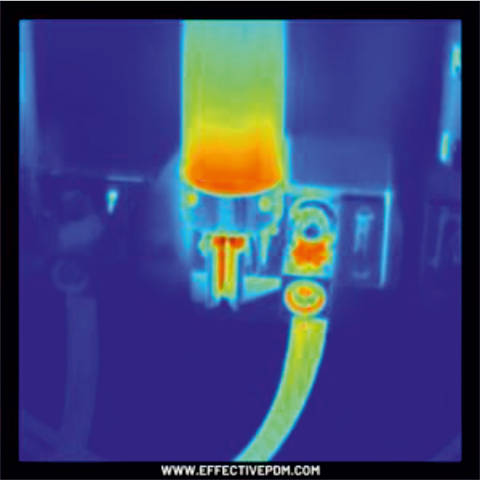
- IR - Infrared Thermography
- ULT - Ultrasound (Airborne and Structure-borne)
- MCA - Motor Circuit Analysis
- VIB - Vibration Analysis
- FA - Fluid Analysis
Stacking Skills
What’s the significance of incorporating infrared (IR) inspections into the skill development of maintenance teams? The answer came from an unlikely (non-maintenance and reliability) source: a book by the creator of the Dilbert cartoon, How to Fail at Almost Everything and Still Win Big, by Scott Adams. In the book, Adams defines “The Success Formula” in which “every skill you acquire can double your odds of success.” The formula looks like this:
Good + Good > Excellent
In other words, you’re better off being good at a couple of complementary skills than being an expert at only one. When applied to maintenance teams, the formula can look like this:
Maintenance Skills + Electrical Skills + Infrared Skills = Enhanced Maintenance Team
Adding the skills of infrared inspections to electrical maintenance creates the foundation of a great skill-stack for every maintenance team. The benefits of stacking maintenance, electrical, and infrared skills could include:
- Faster troubleshooting
- Better understanding of asset failure
- Find previously hidden problems
- A more capable team
Essentially, stacking infrared inspections skills on top of existing maintenance skills produces a confident and capable team. And history has shown that nothing can stop an effective maintenance team.
Not Wasting Big $$$
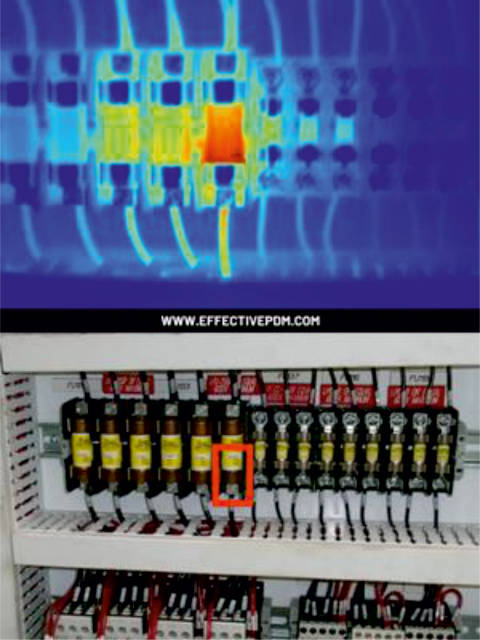 How do infrared inspections contribute to cost avoidance and more efficient cost management in maintenance operations? Fundamentally, predictive maintenance costs less than reactive maintenance and here’s why. With reactive maintenance, an electrical component runs to failure. At failure, there are replacement costs, possible emergency parts and labor, downtime, possible lost product waste, and potential safety costs all added together.
How do infrared inspections contribute to cost avoidance and more efficient cost management in maintenance operations? Fundamentally, predictive maintenance costs less than reactive maintenance and here’s why. With reactive maintenance, an electrical component runs to failure. At failure, there are replacement costs, possible emergency parts and labor, downtime, possible lost product waste, and potential safety costs all added together.
When comparing reactive to preventative maintenance (time-based maintenance), there’s partial electrical component replacement costs, scheduled downtime for parts and labor costs, and non-problem component replacement waste. When comparing preventative maintenance to predictive maintenance (condition-based), there are partial replacement costs, scheduled downtime, and problem-only replacement — resulting in the least expensive form of maintenance.
According to a 2019 Hartford Steam Boiler study, infrared inspections have a 5:1 cost-avoidance, conservatively based on parts and labor versus reactive maintenance. The cost-avoidance when tracked can be even more impactful.
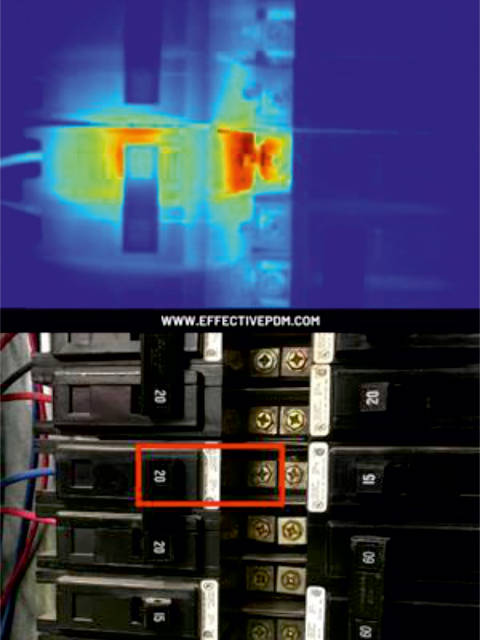 Some numbers we tracked over six electrical infrared inspections from one of our customers resulted in:
Some numbers we tracked over six electrical infrared inspections from one of our customers resulted in:
- 20:1 repair to replace ratio (parts and labor only)
- 65:1 total infrared cost avoidance (parts and labor, lost production time, lost product)
- $44,937.00 total IR + repairs cost before failure
- $2,269,120.00 total avoided cost of failure
Cost-avoidance can get serious quickly when implementing infrared inspections.
When talking about more efficient cost management for maintenance teams, infrared inspections help with that too. We’ve established that reactive maintenance is more expensive than predictive maintenance. If a maintenance team wanted to start a PdM program, infrared has the lowest barrier to entry.
One inspection tool can pinpoint problems from high voltage on down to 24-volt systems and across thousands of electrical assets. Infrared thermography is also easy to learn and (with effective training) easy to apply. Starting your PdM program with electrical IR inspections allows you to pick off the low hanging fruit and produces results quickly.
The initial investment in tools and training is minimal compared with other technologies like vibration and motor circuit analysis. As soon as a maintenance team starts using infrared, they’ll be finding small problems early and making inexpensive corrections. Ultimately, they’ll be saving their company money.
Ensuring Electrical Safety
How do infrared inspections mitigate electrical safety risks in manufacturing facilities? Infrared inspections and electrical safety tie together with these three words: normal operating condition. The NFPA 70E Standard for Electrical Safety in the Workplace tells us that electrical equipment should not be running unless a “normal operating condition” exists. To meet that criteria, electrical equipment must:
- Be properly installed
- Be properly maintained
- Be used in accordance with manufacturer’s instructions
- Have doors closed and secured
- Have all covers closed and secured
- Have no evidence of impending failure
Infrared inspection programs help solve for the “no evidence of impending failure” part better than any other maintenance type.
More proof that infrared inspections mitigate electrical safety risks was recently published inside the 2023 NFPA 70B Standard for Electrical Equipment Maintenance. In Section 7.2.1.1 Infrared Thermographic Inspection of Electrical Connections, “Infrared thermographic inspection of electrical connections and terminations shall be performed in accordance with Section 7.4.” Why would the new standard make annual electrical infrared inspections mandatory? Here’s a great answer from the previous version (2019):
4.2.1 “A well-administered EPM program reduces accidents, saves lives, and minimizes costly breakdowns and unplanned shutdowns of production equipment. Impending troubles can be identified — and solutions applied — before they become major problems requiring more expensive, time-consuming solutions.”
Source: 2023 NFPA 70B Standard for Electrical Equipment Maintenance
How much safer would your team members and facilities be by eliminating these hazards? By training your maintenance team to implement infrared inspections at your facility, you’ll help mitigate electrical safety risks.
Maintaining Uptime
What are some practical strategies and best practices to drive operational efficiency and achieve excellence by leveraging infrared inspections in maintenance practices? To move from reactive maintenance to proactive maintenance, you’ve got to stop “firefighting”.
If “firefighting” is reactive maintenance, why not eliminate the fire before it starts? Here’s the typical fire-starting steps:
Spark > Tinder > Kindling > Firewood > Big Fire
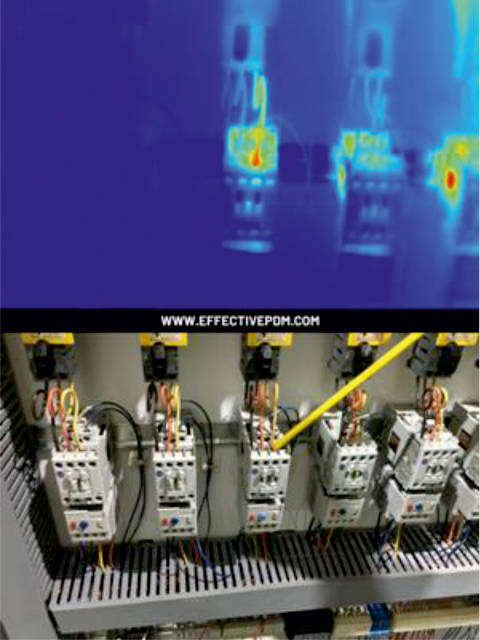 If a spark doesn’t have tinder, a fire won’t even start. Eliminate the tinder. Here are some examples of “tinder”:
If a spark doesn’t have tinder, a fire won’t even start. Eliminate the tinder. Here are some examples of “tinder”:
- Loose (high resistance) wire connections in control panels
- Overloaded circuit breakers in panels
- Obstructions blocking electrical equipment
- Missing circuit breaker filler plates in panels
- Loose (high resistance) fuse clips in control panels
This is all “tinder” that can be eliminated using infrared inspections so your team can stop “firefighting” which is reactive maintenance.
Another best practice to drive operational efficiency is for your maintenance team to start bringing their IR imagers along for troubleshooting situations. During the day-to-day maintenance calls, observing the same problems using infrared will:
- Show them a new perspective
- Find any excess heat
- Catch obvious IR issues on the spot
Ultimately, there’s no point to have an expensive predictive maintenance tool just sit on the shelf.
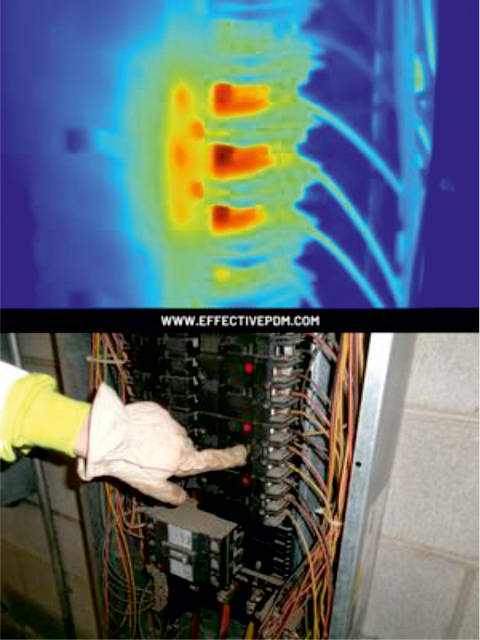 Another tactic that leads to maintenance excellence is to create a list of critical assets to inspect regularly and break the total asset list up into manageable chunks. To do this, you’ll need:
Another tactic that leads to maintenance excellence is to create a list of critical assets to inspect regularly and break the total asset list up into manageable chunks. To do this, you’ll need:
- A complete asset list of your facility
- Knowledge of what’s critical to operation
- Systematic way to plan an inspection route
In-house maintenance teams are at an advantage, they can inspect the whole electrical system when they want to and break the asset list up into manageable chunks to inspect throughout the year.
A final best practice that will drive operational efficiency is to remember that IR inspections are only effective when followed by timely repairs. A real-life example brings this point home. I tell it as a cautionary tale of “The $200,000 Fuse Clip.” Check this out:
An inspector friend of mine completed an electrical infrared inspection on a main disconnect of a new restaurant down in Florida. He found that the main disconnect had a loose (high resistance) fuse clip that he reported as an anomaly. The restaurant owner received the report and never hired a contractor to fix it. Two weeks later, the new restaurant started serving customers and as the electrical load increased, the connection got worse and eventually started a fire. The restaurant owner lost $200,000 between renting a generator to finish an event starting the same night as the fire plus replacing the service. Now, he wants him to inspect the restaurant at least annually.
IR inspections are a snapshot in time and there’s no way to tell exactly when an electrical component will fail. That fuse clip could have been corrected for minimal cost but instead turned into a $200k bill. By following these tactics and best practices, your maintenance team can harness infrared inspections to maintain uptime.
No Death-By-PowerPoint
How can we best approach training the next generation of maintenance teams? A seemingly non-obvious answer is that training should be like watching YouTube — educational, tactical, and a bit entertaining. The next generation does not need more tired voiceover and death-by-PowerPoint training that plagues the corporate world.
Think about the last time you wanted to learn something. What did you do? I bet you didn’t crack open a crusty old textbook. No, you Googled something and watched a YouTube video.
Training a maintenance team today should follow these best practices:
- No elaborate theory and overview fluff
- Learn from practitioners, experts, and doers
- Training must achieve a transformation/result
- Must be mobile-first training (for online courses)
The next step to best approach training the next generation is to provide a step-by-step system or playbook they can implement immediately. Information is unlimited, the future of maintenance training is providing a system to utilize that information in the best way possible. You can apply this information directly using:
- Standard Operating Procedures (SOPs)
- Guides (video or written)
- Templates
- Cheat sheets
Templates, cheat sheets, and SOPs can all be managed with mobile-first CMMS. Most now even incorporate artificial intelligence A.I. into SOP management.
Lastly, IR is straightforward but not easy, good training is essential. Unfortunately, executing an infrared inspection is not as simple as “buy an IR imager, point, and shoot.” There’s more nuance that has to do with the art of thermography versus the science of it. A huge part of being a good thermographer is being able to accurately gather data that leads to great reporting.
When it comes to effective training, you’ll want to learn how to inspect facility electrical system assets and identify electrical infrared and visual problems. Often, an “on-the-job” style training is best. The next time you get to train a maintenance team member, adapt to where we are today, not to where training was 30+ years ago.
And please, no more death-by-PowerPoint training!
Conclusion
It’s no secret that maintenance needs a rebrand and maintenance teams have an uphill battle. Incorporating infrared inspections into the skills development of maintenance teams will help fight that battle. By stacking skills, not wasting big money, ensuring electrical safety, maintaining uptime, and dropping the death-by-PowerPoint training, your maintenance team will be empowered to succeed by implementing infrared inspections taking them from training to triumph.
Challenge your company to implement one tactic from this article and get after it!
